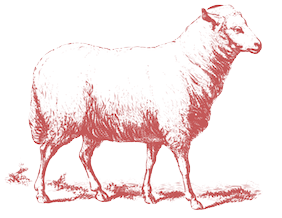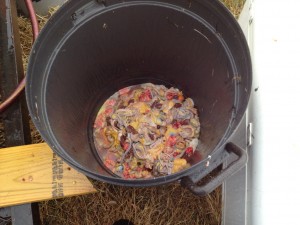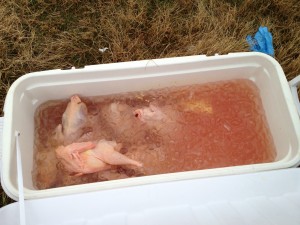Over the past two days we have been killing chickens. A lot of chickens. As our farmers' market customers know, we've been short on eggs. Really short. This is because our hens were going on three years old. For a hen, that's old; much too old to be a mama hen anymore (and let's face it, what wild, ancestral, jungle chicken ever even made it to age 3?) and so, her body stops laying eggs. At this point, the birds are only good for two things: entertainment and the stock pot. Since the entertainment value of a chicken (and they are funny creatures! I often tell my customers that if you have chickens, you don't need TV!) is somewhat less than its food value and a good deal less than its nutritional value, we rented a plucker and scalder from Darby Farms and went to the messy, messy task of harvesting some 200 birds.
For those folks not well-acquainted with chicken killing, here are the basic steps: kill, scald, pluck, gut, chill, pack. While this summation seems straightforward, slightly more detail renders a more accurate picture:
1. Catch the bird. This is harder than it seems. Have you ever tried to catch a chicken? In some cultures, catching a chicken is considered a right of passage for young boys who wish to become hunters (y'all remember that scene from Roots?). Generally, chicken catching is best done at night (or with a leg snare, but who has the time?), since they become unusually docile and willing. We went out at dark, snatched up the birds in crates, and brought them to a room in the barn for easier bird-napping on the day itself.
2. Place bird, head-first, in cone. Killing cones are the standard, tried-and-true method for killing poultry. They are essentially a cone with a hole in the bottom wide enough for the birds head to come through.
3. Cut veins on sides of neck. Chickens have two veins on either side of their necks that push a large volume of blood pretty quickly. Feathers, however, can make getting there a little difficult. That and figuring out exactly how much force to use based on the thickness of the bird's skin, the sharpness of the knife, and the strength of your nerve.
4. Wait for the bird to bleed-out and die. You know the phrase, "running around like a chicken with its head cut off"? Well, whether or not you cut off the head, wring the neck, or slit the veins, it doesn't matter; short of obliterating the poor bird, chickens have a violent nervous system response as they die. Shortly after the loose consciousness, the autonomic nervous system fires up, causing them to convulse, their wings to flap, and if they are on their feet, they can run for a bit. This is highly alarming to the uninitiated, but rest-assured, the bird feels nothing at this point.
5. Place the bird in the scalder. This is essentially a hot water bath, around 140F. The bird goes in for a minute or two, until the water has penetrated the feathers and reached the skin. The heat causes the pores the feathers grow out of to dilate, loosening the feathers. Ever smelled a wet, dead chicken? It's not far off from a wet dead rat.
6. Place the bird in the plucker. This is perhaps the most grisly part of the process. A plucker is a tub lined with rubber "fingers" that rotates the carcass. As the carcass makes contact with the rubber fingers, the feathers are pulled out. It is an odd bit of physics I don't fully understand, but it works. But it is slightly horrifying to see the body of a bird slowly shifts from something solid and defined into this naked thing, flopping about lifelessly and erratically. The plucker is this liminal space where the bird transforms from a chicken into meat. It is an eerie thing to behold.
7. Remove the head a feet. Use a big knife, find a joint, and whack. It makes you feel like a butcher. Or an axe murderer. But you know, in a macabre-humor sort of sense.
8. Gut. This is the most "involved" part of the process. If you've never gutted a chicken, you should. Essentially, you make an incision at the belly, just under the breastbone, pull the cavity open a bit, reach way in to find the esophagus, and gently but firmly pull out, bringing most everything else with you as you go. It is very important to be gentle with the intestines and to cut the "vent" or cloaca out carefully to prevent poo from landing on the meat (not for nothing is it called a cloaca-- latin for "sewer," so know where your blade is going!). You can also imagine why gutting might be the best job if you're butchering on a cold day.
It was suggested while we were working that instead of dissecting frogs in high school (a fairly pointless killing of an animal), students should gut chickens (I know, I can see the angry letters from parents now... but go with me here) and then eat them. If you're interested in what's inside a chicken, I highly recommend taking a look at this chapter on chicken anatomy from the University of Kentucky's Ag Extension. It is as beautiful as it is fascinating.
9. Chill. Well, actually you rinse first, with a bit of cold water, inside and out to remove any excess blood and guts. Then chill the bird down in an ice bath to maintain freshness and facilitate freezing.
10. Pack. Take the bird out of the ice bath, shake off excess moisture, and put it in a thick, plastic bag (or vacuum sealer) and seal. This is where tool selection is vital. We thought we had the correct sealer for our bags, but they were too thick and would not go through the mechanism. So we taped each bag. By hand. Enjoy your "artisan" packaging!
Now, some of this sounds brutal, but the reality is that it is no more brutal than it has to be and a good deal less brutal for the chicken than a natural death might be. I've written here before about the ethics of killing animals for food, and my experiences have upheld my beliefs and understandings about this process over time: the cones, while seemingly unnatural actually calm the chickens rather well, while the cutting (if done with a sharp knife) is not very painful, and bleeding out is perhaps one of the most serene ways to to die. It is also an economic necessity for us farmers. When the birds are young, they eat a lot of feed, but don't lay any eggs. They basically live on the farm rent free for the first 4-5 months of their lives. At the end of their lives, we recoup that cost by selling the meat.
An wow, what meat it is! These birds are not your plump little roasters that you can put a lemon and a bay leaf in. No. They are scrawny, tough, taste strongly of chicken, and have great hunks of the yellowest, purest fat you can imagine: pure, distilled sunshine and grass. These birds are meant to be stewed. To be transformed from a boney carcass into the richest, most flavorful, most nutrient-dense broth you've ever had in. your. life. Seriously. This is the stuff of your grandmother's kitchen. I've been known to drink it with a straw. Here's why.
So all you egg-buyers out there! While you're waiting for our new crop of chickens to start laying in the spring, enjoy the hens who have been feeding you these past years in a different way! Come grab your stew hen at the Peacthree Rd Farmers' Market this Saturday until we sell out...



